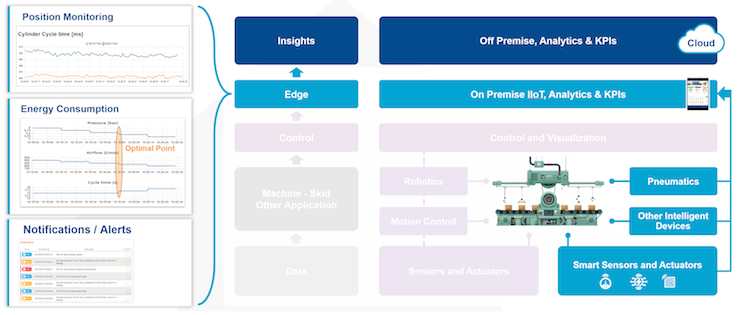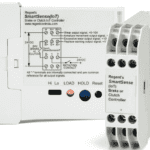With IoT-capable hardware and software readily available, engineers are seeing the benefits of including IoT functionality into new machine designs by default.
Rich Carpenter
Silvia Gonzalez
Emerson
Rapid developments in the consumer electronics realm have become a general expectation of users everywhere, with vendor releases each year predictably topping previous iterations for performance, features, and convenience. Larger consumer goods such as appliances and cars improve too, although usually at a slower pace. And all these developments can make technological progress in the area of industrial OEM machinery appear glacial. However, this situation is changing as Internet of things (IoT) and other networking and visualization tools are proving to be applicable to OEM machines, in demand by end users, and more widely available from vendors.
Industrial IoT (IIoT) hardware and software technologies are challenging the conventional wisdom around costs versus benefits because the initial price tag is minimal, while the immediate and future advantages are substantial. Perhaps more importantly, this is coupled with the fact that end users are aware of and are actually pushing for modern IoT capabilities so they can improve operations and future-proof their capital equipment.
End-user demand—along with the ability of OEMs to differentiate their offerings and create longer-term relationships and new business models with their customers—are leading OEMs to the realization that IIoT-capable hardware and software should simply be built-in to all new machines, whether it’s immediately used or not.
The drive for data
OEM machine builders are experts in their products and have typically adopted new technologies with each new machine generation. However, customer demand for reliability and improved efficiency is now also driving OEMs to consider delivering more capable machines. In many cases, responding to these requests requires a deep command of equipment data, compelling OEMs to instrument and enhance their equipment so they can provide the same easy connectivity experience people have today with consumer devices.
What’s more, these end users are looking for more than just raw data; they need actionable information to help them operate machines, locally or remotely, at peak performance. With the right information at hand, these users can improve operating efficiency from all aspects of equipment functionality, consumables usage, and labor—improving profit while reducing risk.

Conventional wisdom holds that OEMs, like any business, are driven by the profit motive to minimize costs and maximize profits. Yet IIoT capabilities are so economical to build-in initially and can deliver such extensive value for end users and OEMs alike in the future that they should be considered as a mandatory feature.
The shift in thinking calls for an OEM to change from building the lowest cost ‘just enough’ functional machine, to building a machine with embedded IIoT that can evolve with customer needs over time via software updates, providing flexibility to meet immediate needs while enabling machines to respond to future demands. This is made possible with the right hardware, software, instrumentation, and networking elements. In addition to traditional automation controllers and I/O, other external intelligent devices and sensors which may not directly be involved with the automation can be incorporated to provide important data for analysis in order to drive stronger insights.
Examples of this additional data are condition monitoring devices for vibration, bearing temperature sensing systems, power utilization signals, compressed air pressure and usage rates, and consumables tracking. By integrating these signals, end users gain operational visibility, including early warnings of component failures and maintenance recommendations. Also, OEMs can create new revenue streams by offering enhanced monitoring and support services for their end customers. Equipment leasing based on production can be quantified, and machine-as-a-service business models become realistic using these connected IIoT technologies.
Making the connection
While automation hardware and software are relatively mature products, it’s been traditionally expensive and difficult to include remote connectivity capabilities in new equipment, and even more costly and impractical to retrofit it at a later date.
Over the past few decades, PLC and HMI devices have become much more capable, and networking and internet technologies have also improved. Despite these advancements, early attempts at IIoT-like applications required extensive coordination between operations technology (OT) specialists for the equipment, and information technology (IT) personnel for networking, data management at scale, and analytics. Building a true IIoT application required custom programming, learning new and unfamiliar technologies, and overcoming various weak links in areas such as connectivity.

Another issue is that end users prefer technologies that are not intrusive with their existing PLC, HMI, and networking infrastructure so they can avoid disturbing the working application, reducing downtime. Ideally, IIoT applications should supplement existing operations, not interrupt them. Users need solutions enabling operators to improve daily production and inventory management, while maintenance personnel focus on maximizing asset uptime, without creating any additional burden.
Even OEMs with strong automation technical resources may not have the total skillset to create these types of IIoT solutions or have a completely clear vision of their end customer challenges, especially regarding cloud connectivity and analytical needs. These OEMs will gravitate toward acquiring complete solutions and working with their automation partners to implement, support, and evolve this digital transformation.
Expensive and difficult becomes economical and easy
Improved standards and an ecosystem of modular hardware and software products taking advantage of the latest IIoT technologies have combined to enable economical, secure and uncomplicated solutions. There are multiple ways to build-in IIoT capability based on edge computing and associated software, but in every case it’s important to consider solutions that could be standardized and implemented in brownfield or greenfield situations, regardless of the existing infrastructure.
Standard PLCs can perform a certain amount of IIoT processing, but a new generation of edge controllers has superseded PLCs by adding the PC-like computing needed for IIoT tasks. Edge controllers maintain full deterministic control capabilities to reliably control industrial equipment even with the added IIoT capabilities. They’ve become the preferred automation platform for OEMs looking to future-proof their equipment designs, even if they’re not ready to take full advantage of the IIoT capabilities today.
When OEMs are ready to move forward with IIoT efforts, the complementary technologies are in place. Industrial Ethernet protocols work well with existing equipment and within factories, and MQTT has risen to prominence as a capable and lightweight method of communicating factory data to the cloud or other IT applications. And instead of custom code, there are now many powerful and well-understood applications like Node-RED and Grafana, which can be configured to seamlessly transmit factory data and visualize it as actionable information.
Of particular interest for IIoT visualization are advanced web-capable HMI software capabilities that move beyond basic visualization to incorporate various IIoT functions. This next-generation software is scalable for application size and can be deployed in a variety of locations, while providing a consistent development experience.

Web visualization is a natural fit for IIoT analytical applications, which usually require visualization from anywhere. Combined functionality and flexible deployment are particular advantages for OEMs, especially those building many varieties of equipment. Some installation options may include:
- Directly on-board an edge controller
- On an edge computing device connected to one or more local controllers and sensors
- On a factory-floor or control room PC
- Deployed on one or more servers as part of a larger automation system
Regardless of the installation type, it’s important for IIoT solutions to be capable of integrating with cloud-accessible systems, especially if the customer or OEM would like to visualize and analyze across a distributed fleet of equipment. Cloud communications is a valuable two-way street, empowering OEMs to support all their customers worldwide. In addition, it lets OEMs monitor many sites—with the proper authorization—so they can perform fleet-level analytics providing great insights for improving equipment design and reliability.
Toward more intelligent automation
Edge control and web-based visualization go beyond basic automation and deliver asset dashboards describing the health of the overall machine, subsystems, and components. Operations and maintenance personnel are alerted if there are any issues, while historical data is available for evaluation by end users and OEM engineers. Digital transformation is collecting the right data in support of improved troubleshooting information, early warning of possible failures, and usage-based maintenance.
As end users are beginning to make IIoT a priority, one OEM of packaging equipment is responding by making their automated systems more intelligent and IIoT-ready. This OEM is innovating by including automation hardware, software platforms, and additional sensors in their products in order to build-in IIoT capabilities enhancing their end customer’s experience. Then, with continuous learning and advancements, they can add additional analytics over time to progressively improve equipment operation.
It’s not enough for suppliers to simply add some converged OT and IT capabilities into their products. OEMs and end users are looking for partners with deep experience in automation hardware and software, who understand the industrial market. The right supplier partner enables OEMs to improve their end customer’s satisfaction by including advanced IIoT capabilities such as analytics and machine overall equipment effectiveness (OEE) reporting.
Moving forward, end users are not likely to accept less data and reduced visibility, especially for miniscule up-front cost savings. This is because they realize the long-term payback and benefits of operating as efficiently as possible and so are now demanding IIoT capable automation platforms.
www.emerson.com/industrial-automation-controls






Leave a Reply
You must be logged in to post a comment.